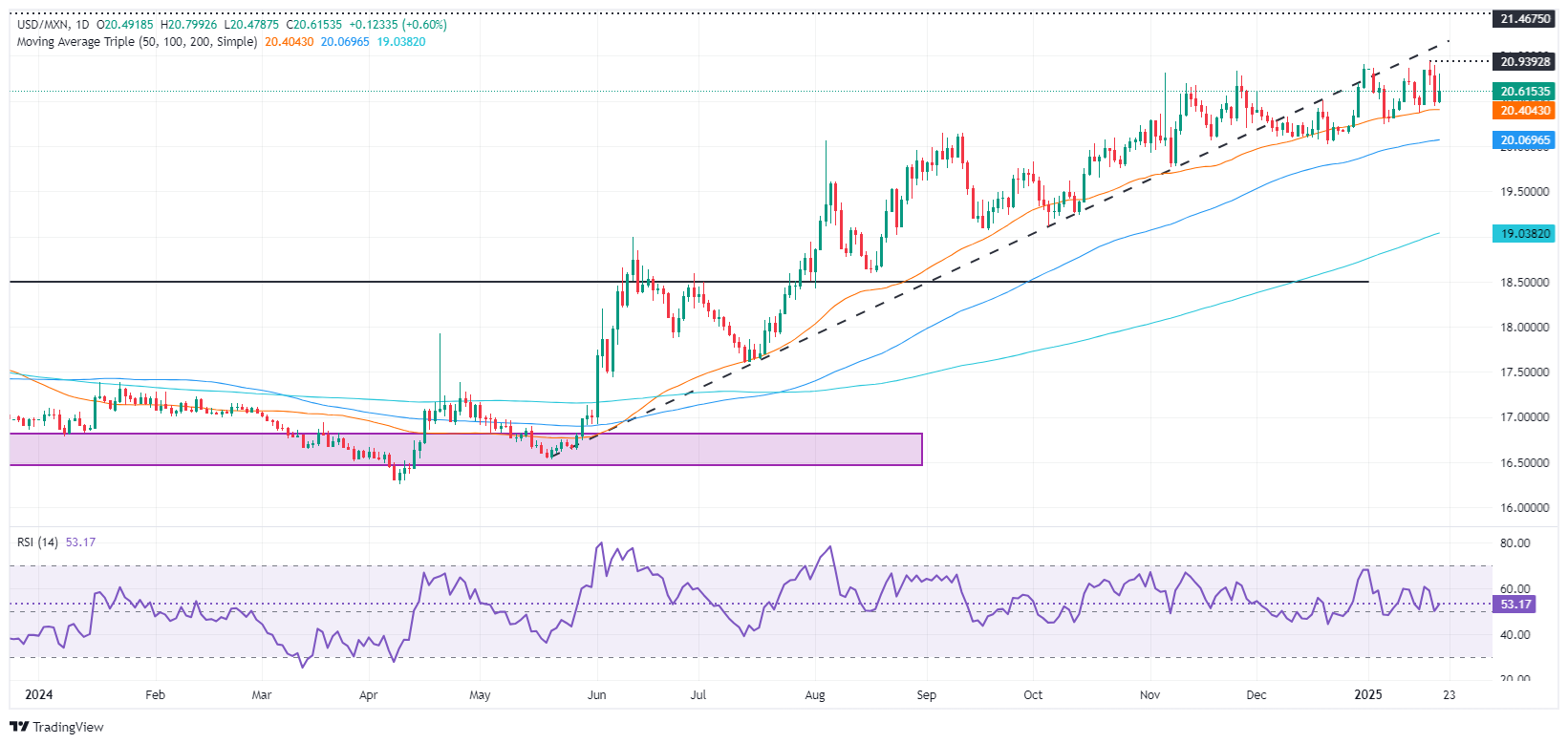Mexican Peso drops on Trump’s tariff threats
- Mexican Peso trims gains post-Trump inauguration amid tariff threats against Mexico and Canada.
- President Sheinbaum commits to defend Mexico's sovereignty, seeks dialogue with heightened US tensions.
- Mexico's Retail Sales show resilience in November; key inflation and economic activity data expected this week.
The Mexican Peso erased some of Monday’s gains on US President Donald Trump’s inauguration day after the latter threatened to impose 25% tariffs on Mexico and Canada as soon as February 1. Therefore, the USD/MXN jumped to a daily high of 20.79, before stabilizing at current exchange rates, trading at 20.59, up 0.60%.
Tariff rhetoric is back following last night Trump’s remarks, sending the currencies of the country’s neighbors plunging versus the US Dollar. However, as Tuesday’s session evolves, the emerging market currency has recovered as fears dissipated.
Tensions between the US and Mexico heightened as Mexican President Claudia Sheinbaum emphasized that she will defend the country’s sovereignty and independence but stressed that she will pursue dialogue with Trump.
Mexico’s Retail Sales in November shrank less than foreseen in monthly figures. In the 12 months through November, sales disappointed investors as the economy continued to show deterioration in consumer spending.
Ahead in the docket, Mexico will feature January’s Mid-Month Inflation figures, and the Economic Activity Indicator for November. Across the north of the border, Initial Jobless Claims for the week ending January 18 and Flash PMIs would update the status of the economy.
Daily digest market movers: Mexican Peso depreciates after two days of gains
- The Mexican Peso main driver of Tuesday’s session was Trump’s tariff rhetoric.
- Mexico’s Retail Sales dropped 0.1% MoM in November, yet improved compared to the 0.3% contraction expected by the consensus. On an annual basis, sales plummeted 1.9%, worse than the 1.2% decrease projected by economists.
- Banxico Deputy Governor Jonathan Heath was dovish, saying that headline and core inflation figures may hit 4% in January, adding that the central bank “does not need to exaggerate a restrictive posture.”
- Divergence between Banxico and the US Federal Reserve favors further upside in the USD/MXN pair.
- Economists polled by Reuters revealed that they foresee Banxico cutting interest rates by at least 150 basis points to 8.50% by the end of the year.
- In the Fed’s latest Summary of Economic Projections, officials estimate they will cut interest rates by 50 basis points.
- Mid-Month Inflation in January is foreseen dropping from 4.44% to 3.93%. Underlying inflation is expected to rise modestly from 3.62% to 3.69%.
- Money market futures have priced in 41.5 bps of Fed rate cuts in 2025, according to CME FedWatch Tool data.
USD/MXN technical outlook: Mexican Peso falls as USD/MXN climbs past 20.50
The USD/MXN has consolidated somewhat near the 20.50 to 20.90 area during the last four trading days, a sign that neither buyers nor sellers are sure about the direction of the pair.
Nevertheless, the reduction of the interest rate differential despite the Greenback being extremely overbought suggests the exotic pair could challenge the 21.00 level. If surpassed, the next stop would be the March 8, 2022 peak at 21.46, followed by 21.50 and the 22.00 psychological level.
Conversely, if the pair tumbles below the 50-day SMA, the next support would be the 100-day SMA at 20.04, which is ahead of the 20.00 mark.
Mexican Peso FAQs
The Mexican Peso (MXN) is the most traded currency among its Latin American peers. Its value is broadly determined by the performance of the Mexican economy, the country’s central bank’s policy, the amount of foreign investment in the country and even the levels of remittances sent by Mexicans who live abroad, particularly in the United States. Geopolitical trends can also move MXN: for example, the process of nearshoring – or the decision by some firms to relocate manufacturing capacity and supply chains closer to their home countries – is also seen as a catalyst for the Mexican currency as the country is considered a key manufacturing hub in the American continent. Another catalyst for MXN is Oil prices as Mexico is a key exporter of the commodity.
The main objective of Mexico’s central bank, also known as Banxico, is to maintain inflation at low and stable levels (at or close to its target of 3%, the midpoint in a tolerance band of between 2% and 4%). To this end, the bank sets an appropriate level of interest rates. When inflation is too high, Banxico will attempt to tame it by raising interest rates, making it more expensive for households and businesses to borrow money, thus cooling demand and the overall economy. Higher interest rates are generally positive for the Mexican Peso (MXN) as they lead to higher yields, making the country a more attractive place for investors. On the contrary, lower interest rates tend to weaken MXN.
Macroeconomic data releases are key to assess the state of the economy and can have an impact on the Mexican Peso (MXN) valuation. A strong Mexican economy, based on high economic growth, low unemployment and high confidence is good for MXN. Not only does it attract more foreign investment but it may encourage the Bank of Mexico (Banxico) to increase interest rates, particularly if this strength comes together with elevated inflation. However, if economic data is weak, MXN is likely to depreciate.
As an emerging-market currency, the Mexican Peso (MXN) tends to strive during risk-on periods, or when investors perceive that broader market risks are low and thus are eager to engage with investments that carry a higher risk. Conversely, MXN tends to weaken at times of market turbulence or economic uncertainty as investors tend to sell higher-risk assets and flee to the more-stable safe havens.



